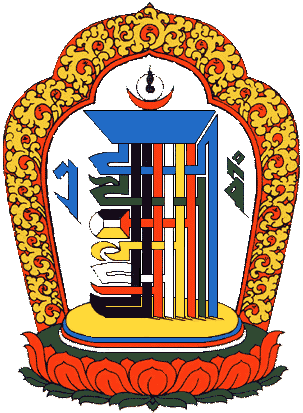The Kalachakra seed syllable (rnam bcu dbang ldan) or Tenfold Powerful
One is the best known symbols of the Kalachakra system, and probably
of the entire Tibetan tantric tradition. The symbol consists of an ornamental
ring of fire, then the main symbol which combines seven individual syllables,
on top are a crescent, a disc and a curved shape, making ten.
 Surrounding
the main symbol is a kind of frame made of flames, which corresponds
to the outermost "Circle of Wisdom" of the mandala.
Surrounding
the main symbol is a kind of frame made of flames, which corresponds
to the outermost "Circle of Wisdom" of the mandala.
On the left and right of the actual Tenfold Powerful symbol are the
Lantsa characters for E and VAM, representing the union of respectively
emptiness (E) and bliss (VAM).
The individual syllables are represented in a in a stylized version
of Sanskrit Lantsa (or Ranjana) characters. (Lantsa is an Indian Buddhist
script, probably of late Pala origin, derived from Sanskrit, although
certain scholars date it as late as the seventeenth century. It was
used in Nepal until recent history. It is specifically used for mantra
syllables and the titles of sacred texts.)
The symbol usually stands on a lotus (which also symbolizes the heart
chakra) and three or four discs, like the Kalachakra deity: a white
moon disc, a red sun disc, a black/blue Rahu disc and a yellow Kalagni
disc. (The Rahu and Kalagni discs are often combined into one black
Rahu disc.)
The symbolism given here is taken mainly from teachings by ven. Kirti
Tsenshab Rinpoche (Graz 1999 and Bodhgya 1990).
However, it must be realised that there can be some differences between
the various Kalachakra traditions. For example, in the explanation below,
the disc above the syllable is white and symbolises the moon, but depending
on the specific symbolism and tradition, it can also be depicted red
and the crescent below can also be white etc., so variations of the
seed syllable are possible; see also this page at kalacakra.org.
The all-pervading space element which is represented by the syllable
A is not represented, but it is automatically present when writing any
consonant in Sanskrit (and Tibetan). In the Kalachakra tantra, there
is a profound symbolic relationship with the vowels and consonants (Ali
and Kali) of the Sanskrit alphabet.
In Tibetan Kalachakra texts, the syllables HAM KSHA MA LA VA RA YA are
often written on top of each other, not as normally from left to right.
Below, the syllable is broken into it's constituent parts to show the
form of each, and also list some of the most basic symbolism associated
with each, related to the Kalachakra mandala. The symbolism goes much
further though, for example in Inner, Outer and Secret Kalachakra (see
Kalacakra seed syllable),
the ten Shaktis, the ten main channels at the heart, the ten perfections
etc. The individual forms shown are not the normal forms they would
take as a syllable, but the shapes in stylised form to combine them
in the overall figure.
The seed syllable further can symbolize for example:
- Aspects of the Outer Kalachakara, like the elements and the ten
planets
- Aspects of the Inner Kalachakra, like channels and chakras
- Aspects of the Alternative Kalachakra, like the initiations, the
10 powers, 10 forces and 10 perfections (paramitas)
| |
A - not drawn (implicit
in Sanskrit consonant syllables)
The A refers to the green Space circle around the mandala
|
LANTSA or
RANJANA
CHARACTER |
| |
The nada or tilaka refers
to the mind mandala |
|
| |
The white disc refers to the
body mandala. |
|
|
|
The crescent refers to the
speech mandala. |
|
| |
The symbol for HAM refers
to the Enlightened Wisdom of the mandala Deities
|
|
| |
The symbol for KSHA refers to
the Body, Speech and Mind of the Deities
|
|
|
|
The symbol for MA
refers to the Mandala Palace, with its four different colors
in the four main directions.
|
|
| |
The symbol for LA refers to
the yellow Earth circle around the mandala palace
|
|
| |
The symbol for WA refers to
the white Water circle around the mandala palace
|
|
| |
The symbol for RA refers to
the red Fire circle
|
|
| |
The symbol for YA refers to
the black Wind circle around the mandala palace.
|
|
| |
The symbol for E refers to Kalachakra (Method)
|
|
| |
The symbol for VAM refers to Vishvamata (Wisdom)
|
|
|
The Protective Fire Ring represents the outermost Wisdom
circle around the mandala
|
|
Also, this symbol can be found in numerous different forms, sizes
and materials, like below, or have a look at Jan
Haag's modern version.
You can now download our special Kalachakra
Screensaver which contains the Tenfold Powerful One for free! It
is suitable for Windows only, just unzip the file and double click to
install.